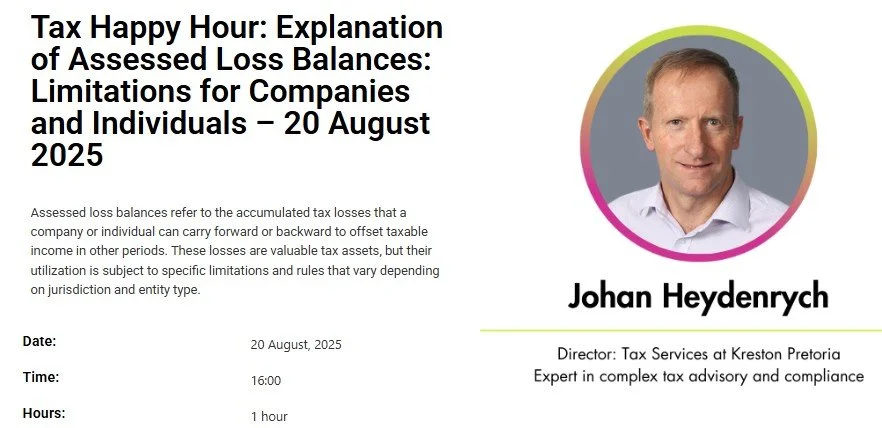Assessed Losses and Silver Lining in Your Business: The Tax Relief Done Right
This article will count 0.25 units (15 minutes) of unverifiable CPD. Remember to log these units under your membership profile.
Assessed losses can be a powerful tax planning tool to reduce taxable income, but only if you understand the rules. Below we look at how companies and individuals can legally use loss carryforward rules, where the pitfalls lie, and how changes in ownership or tax law can limit your tax relief.
What Are Assessed Losses?
In South Africa, an assessed loss arises when a taxpayer’s deductible expenses exceed income in a particular year. Section 20 of the Income Tax Act, 58 of 1962, governs the use of these losses.
Section 20(1) allows a taxpayer to carry forward an assessed loss and set it off against income in future years.
Effective from 1 April 2023, Section 20(1)(b)(ii) of the Income Tax Act, companies are limited to 80% of their taxable income when offsetting assessed losses.
Corporate Taxpayers: What You Can and Can’t Do
Carryforward of Losses
Companies can carry forward assessed losses indefinitely, provided they meet the requirements of continuity of trade and ownership.
✅For Example:
A company incurs a R1 million assessed loss in its 2024 year of assessment.
In 2025, the company earns R500,000 in taxable income. Under the amended section 20(1)(b)(ii) of the Income Tax Act, it may only offset assessed losses up to 80% of that taxable income.
80% of R500,000 = R400,000 may be deducted using the prior year's assessed loss.
This reduces the 2025 taxable income to R100,000, on which the company must pay tax.
The remaining assessed loss of R600,000 (R1,000,000 – R400,000) is carried forward to 2026 and may be used, again subject to the 80% limitation, against future taxable income.
Note: The assessed loss is not forfeited. It is preserved and rolled forward, but its use is capped each year, which can delay full utilisation in profitable years. Strategic forecasting is essential to manage the timing and impact on future cash flows and tax payments.
Limitations Due to Ownership Changes
If a company changes shareholding, SARS may deny the use of carried-forward losses unless the same or similar trade continues. This is based on case law and SARS guidance, particularly the principles outlined in SARS Interpretation Note 33.
No Carryback Allowed in SA
Unlike in the U.S. and some other jurisdictions, South African tax law does not permit carryback of losses to claim refunds on previous years’ taxes. You may only utilise it going forward.
Anti-Avoidance Provision
Section 103(2) (anti-avoidance provision) disallows assessed losses when a restructure is designed primarily to derived benefit from assessed losses.
Group Structures
Understand how assessed losses work in group structures. South Africa doesn’t allow group loss sharing like some countries (e.g., the UK). Each entity must account for its own losses.
Individual Taxpayers: Limited Loss Relief
Business Losses for Sole Proprietors and Partners
Sole proprietors or a partner in a business can generally carry forward trading losses to future years. However, the SARS applies strict anti-avoidance rules under section 20A of the Income Tax Act to prevent taxpayers from abusing this provision, especially when the business doesn’t show a genuine intention to make a profit.
What does this mean in practice?
If SARS believes the business is more of a hobby or side activity with no reasonable prospect of generating taxable income, it may disallow the loss, both for the current year and future carryforwards. This often happens in industries like horse breeding, art dealing, or part-time ventures, where profitability is inconsistent or unlikely.
✅For Example:
A freelance consultant runs a side business in 2024 and reports a R60,000 loss. If the business is operated with a genuine intention to make a profit (e.g. marketing efforts, proper invoicing, client base development), the loss can be carried forward to 2025 and offset against future income.
However, if SARS determines that the activity lacks a clear profit motive—for instance, if the business shows repeated losses without a growth plan—the loss may be ringfenced and not allowed as a deduction.
Tip: To protect your client’s position, ensure there’s sufficient documentation showing that the business is being run in a commercial, income-seeking manner. This could include a business plan, contracts, or evidence of marketing and sales activity.
Capital Losses
Section 20(2) of the Act allows individuals to carry forward capital losses, but these can only be set off against future capital gains.
✅For Example:
If you sell shares in 2024 and incur a R100,000 capital loss, this can only be offset against capital gains in future years, not against salary or rental income.
Time Limits and Expiry
While companies can carry forward losses indefinitely, individuals may face time-based or usage-based restrictions, especially under section 20A and related case law.
✅For Example:
If an individual has carried forward capital losses for many years without generating capital gains, the relief may become functionally useless.
Changes in Circumstances That May Invalidate Losses
Change in control including takeovers or significant shareholding shifts can invalidate corporate losses.
If a company ceases trade, stops trading for a prolonged period, losses can be ringfenced and ultimately expire.
Personal changes including divorce, marriage, or changes in residency may impact the ability to use losses, especially if the loss arose in a different capacity (e.g. jointly held asset).
Documentation Is Key
SARS may disallow losses if there’s insufficient documentation to:
Prove a genuine trade took place
Demonstrate the continuity of operations
Substantiate the amount of the loss claimed.
Keep detailed working papers, tax returns, and supporting schedules.
Become the Expert! Join CIBA’s Tax Happy Hour: Explanation of Assessed Loss Balances: Limitations for Companies and Individuals on 20 August 2025
Think your tax losses are safe? Think again. From sneaky time limits to ownership changes that can wipe your assessed losses clean, this webinar unpacks the landmines hidden in loss carryforward and carryback rules—for both businesses and individuals.
Here’s what you’ll gain:
✅ How to avoid losing your losses after ownership changes
✅ Why SARS might disallow your deduction—and how to stay compliant
✅ The fine print on time limits, group relief, and strategic tax planning
✅ What individuals can (and can’t) offset—and for how long
Whether you’re managing a company or your own finances, you can’t afford to get this wrong.
Heading 4
Lorem ipsum dolor sit amet, consectetur adipiscing elit. Sed do eiusmod tempor incididunt ut labore et dolore magna aliqua. Ut enim ad minim veniam, quis nostrud exercitation ullamco laboris nisi ut aliquip ex ea commodo consequat. Duis aute irure dolor in reprehenderit in voluptate velit esse cillum dolore eu fugiat nulla pariatur. Excepteur sint occaecat cupidatat non proident, sunt in culpa qui officia deserunt mollit anim id est laborum.
List item - monospace
List item - monospace
List item - monospace







